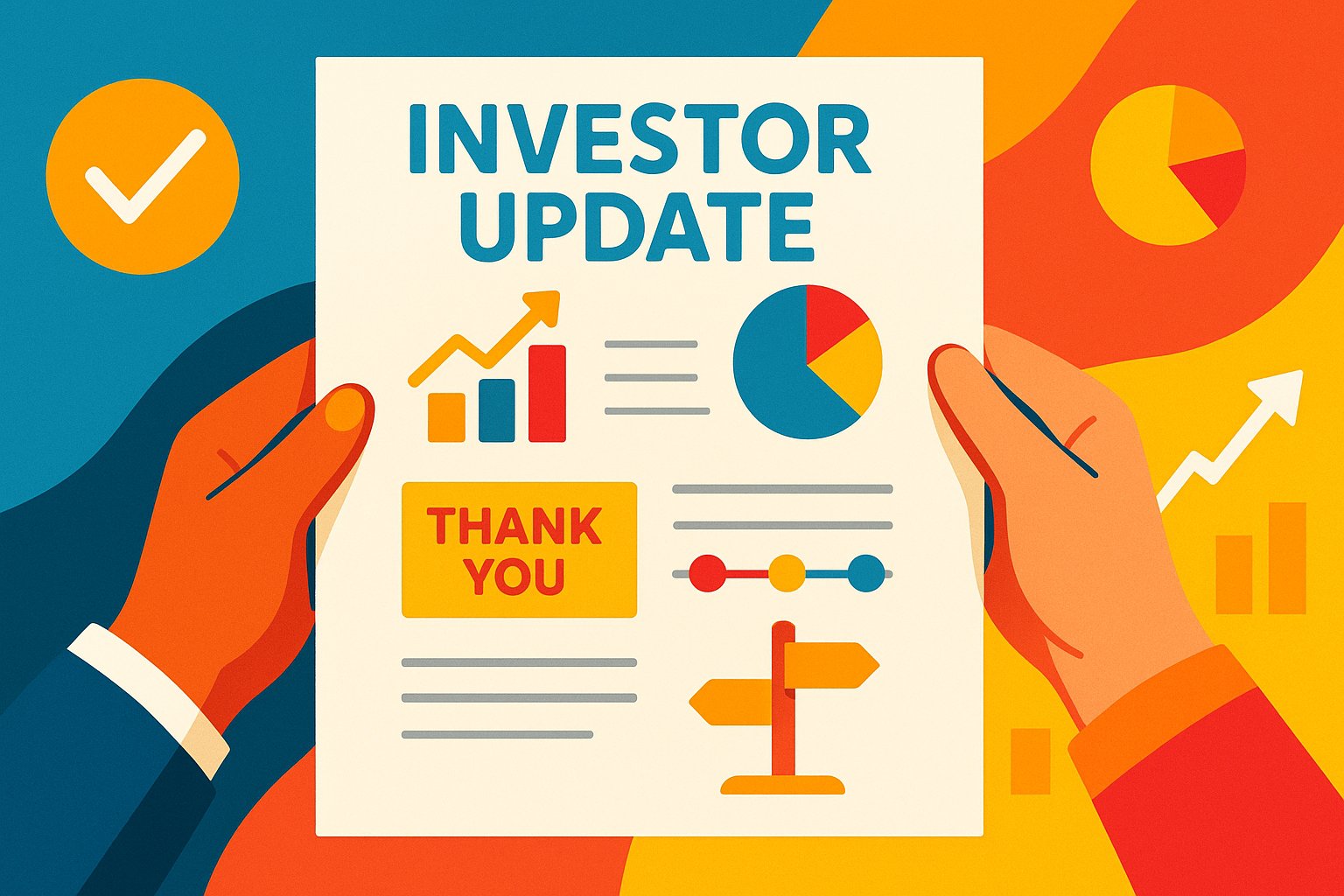Setting the Stage: Your First Communiqué to Champions
Congratulations—you’ve closed your crowdfunding round, secured the capital you need, and welcomed a community of passionate backers into your venture’s journey. Now comes the pivotal moment that separates fleeting excitement from lasting trust: your first investor update. This initial communication does more than report facts; it cements relationships, sets expectations, and demonstrates that you value transparency as much as you cherish each dollar invested. Crafting an update that resonates requires a thoughtful blend of gratitude, clarity, and forward-looking vision, all delivered in a tone that feels both professional and personal. In this opening exploration, we’ll outline why this update matters so critically and preview the essential elements you’ll weave together to transform backers into true advocates from Day One.
Investors who back early-stage ventures often do so with a blend of idealism and pragmatism. They believe in your mission but recognize the inherent risks. Their commitment represents both emotional and financial currency. Your first update is your opportunity to honor that commitment by delivering on three key promises: thankfulness for their support, transparency about your immediate plans and challenges, and confidence in your roadmap. By striking this balance—recognizing backers’ enthusiasm while demonstrating strategic rigor—you’ll reinforce their decision to invest and lay the groundwork for ongoing engagement. Let’s dive into the components that will make your first investor update both memorable and meaningful.
Expressing Heartfelt Gratitude: The Power of Personal Thanks
Every investor update should begin with a genuine celebration of the community you’ve built together. Open by acknowledging the collective effort that brought your campaign to life: the social shares, the referrals, the weekend email marathons, and the unwavering belief in your vision. Avoid generic “thank you” statements; instead, reference specific milestones—reaching 50% of your goal in 48 hours, welcoming your 1,000th backer, or surpassing your funding target by 20%. When you highlight these tangible achievements, you reinforce the idea that each subscriber played an active role.
Consider weaving in a brief anecdote about an early supporter whose story exemplifies the spirit of your campaign. Perhaps a long-time customer who invested aboard your mission to solve a problem they care deeply about. Personal touches like this turn abstract numbers into human connections. Conclude your gratitude section by reiterating how much every contribution means to you and to the broader purpose you pursue. This heartfelt introduction sets the tone for an update that feels less like a dry financial bulletin and more like a conversation among collaborators.
Recapping the Raise: Transparent Campaign Highlights
After expressing thanks, provide a concise recap of the campaign’s performance. Summarize key metrics—total funds raised, number of investors, average contribution size, and timeline to close. Include any noteworthy highlights, such as press features, celebrity endorsements, or institutional partners that joined during the final stretch. If you offered stretch goals or special perks, remind backers which milestones were unlocked and how those additional resources will accelerate your plans.
While celebrating successes is important, balance your tone by acknowledging any lessons learned. If your campaign pacing slowed at certain points, briefly note how you’ll address that in future marketing efforts—perhaps through expanded referral programs or fresh content initiatives. Demonstrating that you’re both proud of achievements and committed to continuous improvement reinforces your credibility. This transparent recap shows investors that you’re fully in control of the narrative and invites them into your analytical process.
Outlining Immediate Next Steps: From Funds to Milestones
With the campaign behind you, investors are eager to know exactly how their capital will be deployed. Dedicate a clear section to use of proceeds, breaking down the primary areas of investment—product development, hiring, marketing, and operational expansion. For each category, specify high-priority actions: “We’ll onboard two senior engineers by the end of Q3 to finalize our beta feature set,” or “We plan to allocate 30% of funds to targeted digital ad campaigns aimed at securing 10,000 new users by year’s end.”
Frame these next steps as an actionable roadmap with rough timelines. Investors appreciate seeing what happens in the coming 60, 90, and 180 days. Even if your schedule evolves, anchoring your commitments in specific timeframes fosters accountability. Where possible, link each planned initiative to campaign promises—such as the new feature you teased in your raise or the expanded support resources you referenced in investor FAQs. This alignment between pitch and execution underscores your reliability and pins stakeholder expectations to real-world deliverables.
Introducing Key Team Additions: Showcasing Growth in Talent
One of the most critical uses of newly raised capital is strengthening your team. In this update, spotlight any recent hires—whether you’ve secured a seasoned CTO, welcomed a marketing lead with industry pedigree, or expanded your customer success roster. For each new team member, include a brief bio highlighting relevant achievements and how their expertise will advance your mission. Emphasize the direct impact of their roles: “Jane Doe joins as Head of Product to accelerate our roadmap and spearhead user experience enhancements.”
If hiring is still in progress, share a status update on your recruiting pipeline. Outline open positions and invite investors—especially those with domain connections—to refer qualified candidates. This transparency on talent acquisition not only underscores your commitment to building a world-class team but also empowers your investor community to contribute beyond capital. Talent introductions give backers confidence that you’re investing in the right human resources, setting the stage for accelerated progress.
Reporting Early Wins: Quick Victories That Build Momentum
While major milestones often take time, showcasing early wins demonstrates that you’re already translating funds into results. Highlight quick successes—onboarding a pilot client, closing a partnership with a complementary brand, or delivering a closed beta to select users. Provide data points where possible: “Our pilot cohort of 20 users achieved a 90% satisfaction score in preliminary surveys,” or “We secured a reseller agreement that places our product in 50 retail locations.”
Even small-scale achievements matter when they validate your strategy and reveal forward motion. Frame these wins as stepping stones to larger objectives. For instance, a positive pilot outcome builds the case for a broader rollout; a strategic partnership paves the way for exponential customer acquisition. By showcasing these early victories, you stoke investor excitement and reinforce that momentum is on your side.
Addressing Challenges with Candor: Transparency When It Counts
No startup journey is without obstacles, and candidly acknowledging challenges can strengthen rather than weaken investor trust—provided you couple each challenge with a clear plan of action. If you’re facing supply-chain delays, explain the root cause, the contingency suppliers you’re evaluating, and any potential timeline adjustments. If user adoption metrics are lagging initial projections, share the insights gleaned from pilot feedback and your targeted experiments to optimize onboarding funnels.
Investors respect founders who confront reality head-on. When you couch challenges within a solution-oriented narrative, you reassure stakeholders that you’re on top of issues rather than blindsided by them. Transparency about setbacks also invites empathetic support: some backers may offer introductions to partner networks or operational advisors who can help you navigate hurdles. This openness transforms obstacles into opportunities for collaborative problem-solving.
Sharing Early Financial Metrics: Burn Rate and Runway Insights
Financial stewardship is a top concern for any equity investor. In your first post-raise update, provide a high-level overview of your burn rate—the average monthly cash outflow—and your runway, expressed in months of operating capital remaining. Frame these figures within the context of your road map: “With the current burn rate of $150,000 per month, our runway extends through Q2 of next year, providing ample time for key deliverables before considering a follow-on round.”
If you’ve secured cost efficiencies or revenue streams that positively impact cash flow—such as pre-orders, subscription pilots, or affiliate agreements—report these contributions. Early indications of revenue generation or expense optimization signal responsible fiscal management. By sharing these metrics transparently, you demonstrate that you’re not only an inspiring visionary but also a grounded steward of investor funds.
Reinforcing Vision and Long-Term Strategy: Keeping Focus Aligned
Amid detailed operational reporting, don’t lose sight of the big picture that attracted investors in the first place. Reiterate your overarching vision—the transformation you seek to bring to your market and the problem you’re uniquely positioned to solve. Connect your immediate next steps and early wins back to this long-term strategy. For example, explain how hiring a senior engineer accelerates your path to regulatory approval, which in turn unlocks a multi-billion-dollar market.
Use evocative language that paints a vivid picture of your end goal—whether it’s empowering millions of users with a life-enhancing app or revolutionizing sustainable manufacturing. Anchoring your update in that aspirational narrative ensures that backers not only follow daily progress but also stay motivated by the grand mission you share.
Inviting Participation: Engaging Investors Beyond Capital
Your first investor update presents a prime opportunity to invite deeper engagement. Encourage backers to join upcoming webinars, participate in feedback sessions, or sign up for product betas. Outline specific ways they can contribute—introducing potential customers, referring talent, or sharing your campaign story within their networks. By providing clear, manageable avenues for involvement, you transform passive supporters into active collaborators.
Consider launching an investor advisory council or scheduling quarterly “town halls” where you tackle burning questions and brainstorm strategic initiatives together. Empowered investors feel a stronger sense of ownership and are more likely to become vocal ambassadors for your brand. By inviting participation early, you create a lifelong community of advocates committed to your venture’s success.
Closing with a Clear Call to Action: Rallying the Troops
End your update with a concise call to action that aligns with your immediate priorities. Whether you want readers to register for a product demo, share your update on LinkedIn, or complete a brief survey on feature preferences, make the next step obvious and simple. A well-crafted CTA transforms passive reading into proactive engagement, fueling both momentum and data-driven decision making.
Express confidence in your collective potential: reinforce that every investor plays a critical role in the unfolding narrative. Remind them that their insights, advocacy, and ongoing support are as valuable as their financial commitment. By closing with clarity and inspiration, you ensure that your first investor update resonates far beyond the inbox—galvanizing your backers to champion your mission with renewed vigor.




